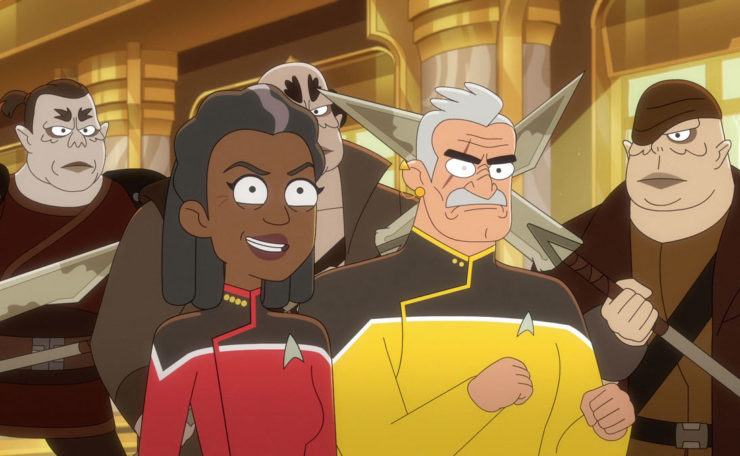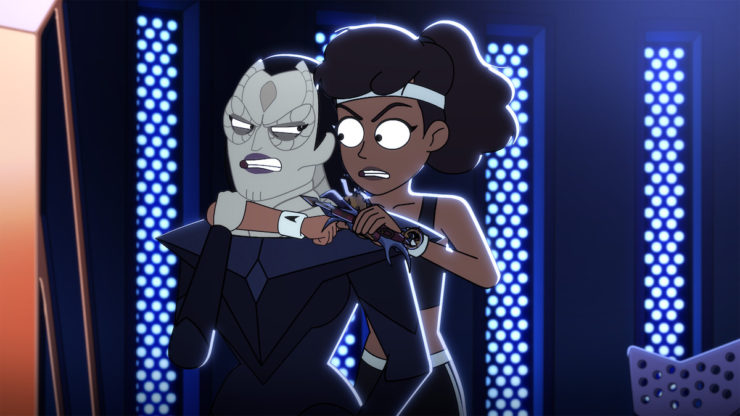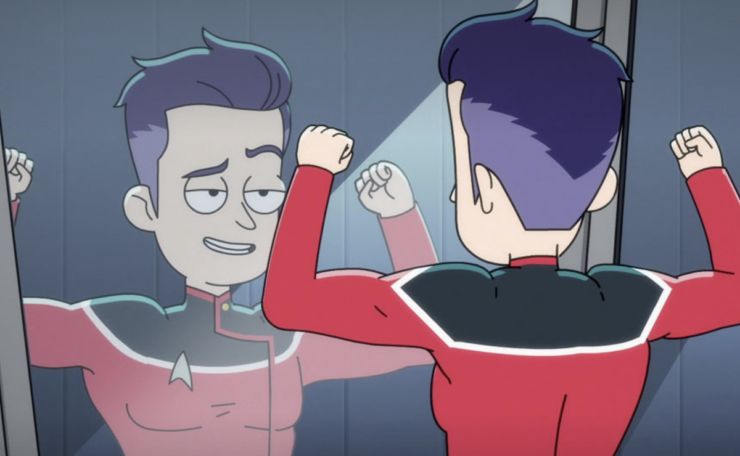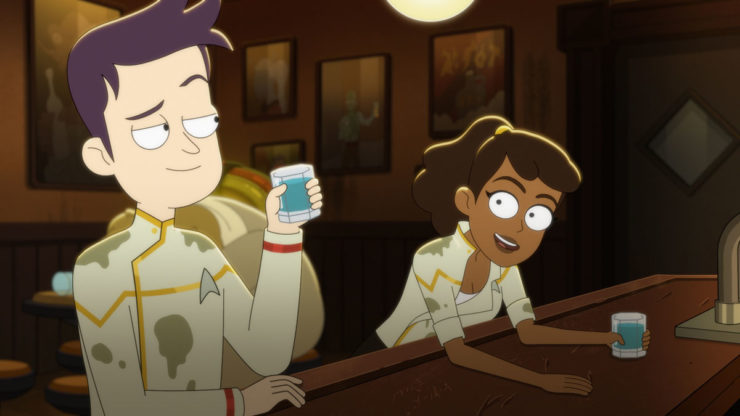After a first season that was horribly hit-and-miss, Lower Decks came back with a second season that fixed several of the first season’s problems, the primary one being that it mostly just sat back and allowed itself to be a Star Trek show, albeit one that was filled with humor and ridiculousness.
Even the reversals of the status quo changes shoehorned into the first-season finale were funny and actually worked in the context of the show. While it’s still not perfect, and suffers from some of the same inconsistent tone as season one, this sophomore outing is a far stronger show than the one that debuted in 2020. And so, we have, in contrast to the first-season roundup, the Good, the Bad, and the Awesome of season two…
The Good

One of my biggest problems with season one was that each script contrived to make sure that Mariner saved the day every time, even when that distinction wasn’t earned. Indeed, some episodes twisted themselves into a pretzel to let that happen. So I was very relieved to see that, in season two, she doesn’t save the day every episode, or even in a plurality of episodes.
They manage to eat their cake and have it too by having Shaxs return in “We’ll Always Have Tom Paris,” but his method of coming back from the dead is shrouded in secrecy. This is exactly the sort of gag that Lower Decks does particularly well, taking a cliché from Trek and shining a funny light on it. Boimler and Mariner are both very blasé about Shaxs’ resurrection, because it’s just something that always happens to the bridge crew. (Witness McCoy in “Shore Leave,” Scotty in “The Changeling,” Spock in The Search for Spock, Picard in “Tapestry,” O’Brien in “Visionary,” Kim in “Deadlock,” Lorca in “Magic to Make the Sanest Man Go Mad,” etc., etc., etc.) And it means we get to keep Shaxs, whom I adore.
Buy the Book


Until the Last of Me
We see more of Captain Riker and the U.S.S. Titan in “Strange Energies” and “Kayshon, His Eyes Open,” and it’s delightful. I especially love Riker’s goofy music references and his gleefully declaring that he loves his job. I hope that season three gives us more of Jonathan Frakes on his spiffy ship…
One of the things we see on Titan is Boimler being duplicated the same way Riker was in TNG’s “Second Chances,” which means that one of them can go back to Cerritos. (Though he’s also demoted which makes absolutely no sense.) It’s a nice way to keep his transfer and keep him on the show’s main ship.
It makes it feel, I dunno, more real to have the season end with a cliffhanger. Like it makes it more of a real Trek spinoff, since every one of the ones that have had more than one season have had at least one cliffhanger.
We get more animated series references, most notably seeing the pillbug people (who have been called Nasats in the tie-in fiction) from “Jihad” (M3 Green was one) and a Pandronian from “Bem” in, respectively, “An Embarrassment of Dooplers” and “I, Excretus.”
There’s a Tom Paris commemorative plate. Which is delightful.
The Bad

The show still way overdoes the references to other Trek shows, though some are at least funny, like T’Ana not know who Dax is and the holographic Boimler being captured by Cardassians and saying, “They keep showing me lights.” It’s the unsubtle jokes that are the biggest issue, truly.
After going to the trouble of having a new tactical officer who’s Tamarian, thus opening up to lots of jokes based on his metaphor-based speech patterns, they proceed to do precisely nothing with it. In his introductory episode Kayshon only has one or two lines in Tamarian before reverting to English speaking patterns, and then is taken out of the action early in the episode. He mostly talks regularly, when he even shows up and has dialogue (he has several dialogue-free cameos), with his Tamarian speech patterns only really used once as a conversational stumble by Boimler in “wej Duj.” The character looked to be one of the more entertaining additions to the cast, and is instead the weakest.
We get two new rivals for Mariner to bitch about, Jennifer the Andorian and Lieutenant Jet. The former is just not that interesting, though I do like the rapprochement the two reach in “First First Contact,” and Jet was set up to become part of the lower-decks dynamic in “Kayshon, His Eyes Open,” only to barely ever be seen again.
The show still relies way too much on dumb office-sitcom plots, whether it’s Freeman’s evaluation that says she micromanages too much or Boimler not being able to walk through doors because they won’t open for him due to new security measures or the replicators having better choices for bridge crew than lower-decks crew.
A couple of times, the show went for brutal violence being funny in a way that brutal violence really shouldn’t be, whether it’s Mariner beating the crap out of Rutherford and Boimler in “Mugato, Gumato,” which was just awful on every level (especially with the two of them covered in bandages in their next scene) or Tendi trying to perform invasive surgery and vivisection on Rutherford to “help” him in “Strange Energies.”
Badass Pakleds was funny in “No Small Parts,” but the joke wore thin this season, especially with the Pakleds being played as even stupider than they were in TNG’s “Samaritan Snare,” particularly in “The Spy Humongous” and “wej Duj.”
The Awesome

I am loving Badass Boimler! He rescues the Titan away team, which also results in his duplication! He saves the day in “The Spy Humongous,” “Where Pleasant Fountains Lie,” and “First First Contact,” and is the only Cerritos crew member to do well in the holodeck scenarios in “I, Excretus.” Instead of being the guy who is eager to be a great officer but who keeps getting in his own way, he’s actually starting to become the great officer he wants to be. It’s a process, mind you, and he still has his moments of incompetent doofiness and bad luck, particularly in “We’ll Always Have Tom Paris” and “First First Contact,” but that just makes it more interesting and fun.
Some superlative guest stars: Jeffrey Combs is magnificent as the voice of Agimus, the world-controlling computer that Boimler and Mariner must bring to the Daystrom Institute in “Where Pleasant Fountains Lie.” Richard Kind is whiny perfection as Doopler in “An Embarrassment of Dooplers.” And Robert Duncan McNeill (Paris), Alice Krige (the Borg Queen), and Lycia Naff (Gomez) all reprise their live-action roles.
Tendi gets a backstory in “We’ll Always Have Tom Paris,” where we find out that she’s actually the Mistress of the Winter Constellations. We only get hints of her life as an Orion before joining Starfleet, but the fact that this sweet young woman has a dark past is just hilarious. (“FALSE GREEN!”)
Billups also gets a backstory in “Where Pleasant Fountains Lie,” and it’s glorious. I love the planet of the Ren Faire people, I love the ostentatious design of the royal ship that belongs to Billups’ Mom, and I love that Billups’ Mom is a regular “guest” on the Cerritos and constantly tries to get her son to go back to being a prince instead of an engineer.
Seeing three (or five) other ships and their lower decks was a masterstroke in “wej Duj,” and I hope we see more especially of Ma’ah and T’Lyn in season three.
We finally see Cetacean Ops! And we meet Kimolu and Matt! And they’re wonderful! More Kimolu and Matt, please! (And yes, I already ordered my Kimolu and Matt sweatshirt. It should arrive soon…)
Overall, the show is moving in very much the right direction, coming into its own as a proper Trek show and actually moving the characters forward. Let’s hope for more of that in season three, and also fewer dumb office-sitcom plots…
And more Kimolu and Matt!
Keith R.A. DeCandido is looking forward to the debut of Star Trek: Prodigy next week, which he’ll be reviewing.










